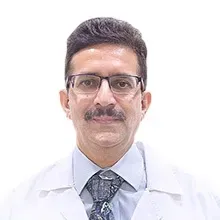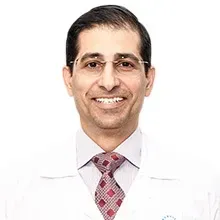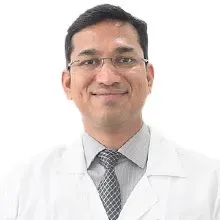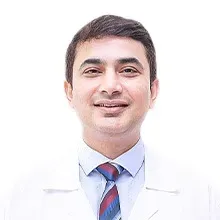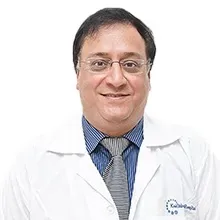Dr. Avinash Date is one of Mumbai's most experienced and well-known orthopedic surgeons. He has been practicing for almost 26 years and is an expert in trauma and arthroplasty. Dr. Date
earned his MS in Orthopaedics from the prestigious KEM Hospital. He then completed his DNB (Ortho) and MRCS and FRCS degrees in the UK. He has received joint replacement training from many nations, including France, Australia, and the UK. Also from Germany and the UK, Dr. Date completed introductory and advanced training in computer navigation surgery. His areas of expertise include Shoulder, knee, and Hip Arthroplasty (Joint Replacement using Computer navigation), Complex primary and Revision joint replacement surgeries, and complex trauma and reconstruction surgeries.
Work Experience
26 Years of Experience Overall
In Andheri West, Mumbai, Dr. Avinash Date practices orthopedic surgery and has 26 years of expertise in the area. At Kokilaben Dhirubhai Ambani Hospital in Mumbai's Andheri West, Dr. Avinash Date sees patients. He earned his MBBS from the University of Bombay in 1990 and his MS in orthopedics there in 1994. Dr. Avinash Date earned his postgraduate degree in orthopedics from KEM Hospital and spent three years teaching at LTMG Hospital in Sion. He has held the positions of consultant and HOD at many multispecialty hospitals in Mumbai. He was also serving as faculty for arthroscopic surgery courses at Droitwich, UK. He completed his fellowship in knee surgery at Toulouse, France's Clinique Des Cedres International Centre for Orthopaedic Education. In Adelaide, Australia, he completed an Asia Pacific Fellowship in Lower Limb Arthroplasty. He spent six years working in the UK and learned a lot about trauma and arthroplasty. During this time, he mastered advanced joint replacement procedures, such as computer navigation.
Associated with Hospitals
Kokilaben Dhirubhai Ambani Hospital, Mumbai
List of Treatments
Dr. Avinash is offering the following treatment procedures:
• Artificial disc replacement: In artificial disc replacement, the prosthetic, or artificial disc, is placed in place of the worn or damaged disc material between the vertebrae.
• Degenerative Spine Disorders: Degenerative spine diseases cause the spine's natural structure and function to gradually deteriorate over time. They may result from tumors, infections, or arthritis, but aging is typically a factor in their development.
• Ankle-Brachial Index: The ankle-brachial index is a non-invasive technique for determining vascular status. It comprises the ratio of the ankle's systolic blood pressure to the upper extremity's systolic blood pressure.
• Arthritis and Pain Management: Arthritis is the medical term for swelling or joint inflammation. It encompasses more than 100 ailments that have an impact on connective tissues, joints, and surrounding tissues. Surgery for arthritis can aid in repairing or replacing a damaged joint. By doing this, it can ease discomfort and enhance the performance of the damaged joint.
• Anterior Cervical Discectomy and Fusion (ACDF): This is a surgery to remove a herniated or degenerative disc in the neck. An incision is made in the throat area to reach and remove the disc. A graft is inserted to fuse together the bones above and below the disc.
• Joint Replacement Surgery: In this surgery, parts of an arthritic or diseased joint are surgically removed and replaced with prosthetic devices made of metal, plastic, or ceramic during a total joint replacement. The prosthesis is intended to mimic the motion of a healthy, normal joint.
• Spinal Decompression: It is a procedure used in orthopedics or neurosurgery to connect two or more vertebrae. This technique stops any movement between the fused vertebrae and can be done at any level of the spine.
• Knee Arthroplasty: A knee replacement, commonly known as knee arthroplasty or a complete knee replacement, is an operation to repair an arthritis-damaged knee. The kneecap and the caps on the ends of the bones that make up the knee joint are made of metal and plastic.
• Revision Hip Replacement: A total hip replacement (THR) reoperation is referred to as a hip revision (sometimes known as a "revision hip replacement"). The prosthesis that is inserted during the initial surgery is completely or partially replaced during this subsequent procedure.
• Arthrodesis: During an arthrodesis, an orthopedic surgeon physically straightens out the injured joint by removing the cartilage and stabilizing the bone so that the bones can heal together.
• Patella Femoral Replacement: Partial knee replacements, like patellofemoral replacements, only resurface a section of the knee. For patients with modest damage to the bone and cartilage on the underside of the kneecap, the surgery serves as an alternative to complete knee replacement.
• BMHR: Birmingham Mid-Head Resection (BMHR) prostheses are implantation techniques used for the treatment of hip osteoarthritis in young patients in order to preserve as much bone material as possible.
• Lower Femoral Osteotomy: In a distal femoral osteotomy, the end of the femur is surgically fractured, changing the form of the bone. The proximal (upper) end of the thigh bone, commonly known as the femur, is cut and aligned during this procedure.
• High Tibial Osteotomy: An operation called a high tibial osteotomy realigns the knee joint. By maintaining damaged joint tissue, this procedure may help certain patients with knee arthritis delay or avoid the need for a partial or full knee replacement.
• Limb Lengthening Procedures: Limb lengthening procedures are surgical procedures that can lessen or eliminate limb-length disparities. The procedure stretches the surrounding muscles, tendons, and ligaments, as well as lengthening a patient's arm or leg bones.
• Cosmetic Surgery: Cosmetic surgery, commonly known as plastic surgery, is performed to alter a person's appearance. For some, it may imply reshaping the body's contour and form, reducing wrinkles, or removing areas of hair loss.
• Pediatric Fracture Treatment: A pediatric fracture, also known as a child bone fracture, is a medical ailment in which a kid's (someone under the age of 18) bone is cracked or shattered.
• Growth Plate Injuries in Children: Injuries at the growth plate are those where tissue forms towards the ends of long bones in children and adolescents. Treatment options include closed reduction, in which the clinician manipulates the bone with their hands to align and set it. Reduced openly. Surgery may be necessary for some growth plate injuries to realign and fix the bones.
• Rhinoplasty: Rhinoplasty is a procedure that alters the appearance of the nose. Rhinoplasty may be performed to enhance respiration or to modify the look of the nose. The top section of the nose's structure is made of bone. The lower half is made of cartilage. Rhinoplasty can alter bone, cartilage, or skin, or all three at the same time.
• Minimally Invasive Surgery: Minimally invasive surgeries are those surgical procedures that do not require any kind of major incisions in the body. To perform the procedure, tiny surgical instruments are placed into additional incisions
• General Surgery: The general surgery department offers a wide array of surgical procedures, ensuring the highest standards of care and safety.
• Congenital diseases: Congenital diseases are structural or functional defects that arise during fetal life. Genetic treatments are techniques to treat congenital problems that include inserting new DNA into specific cells or repairing the DNA.
Education and Training
-
MBBS, University Of Bombay, 1990
-
MS, Orthopaedics, University Of Bombay, 1994
Trainings/Specializations
Registrations
Special Interest










